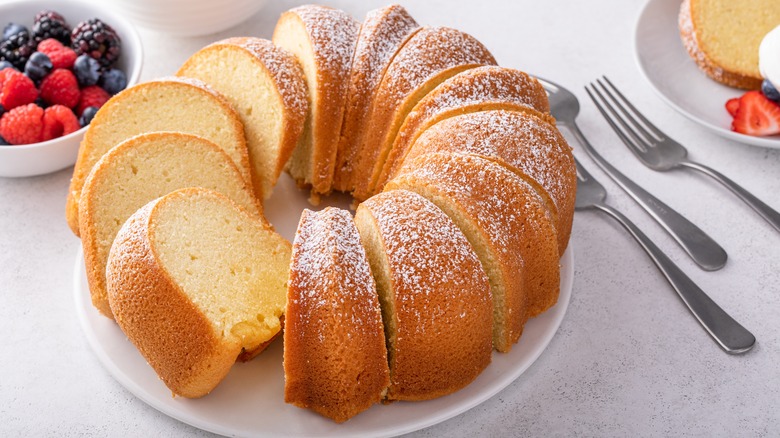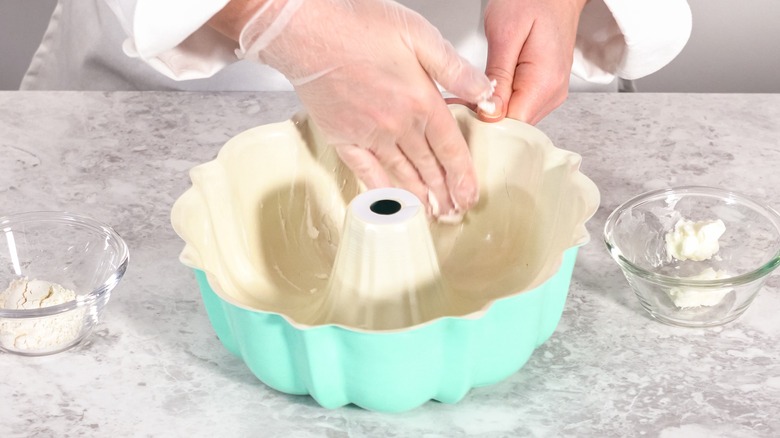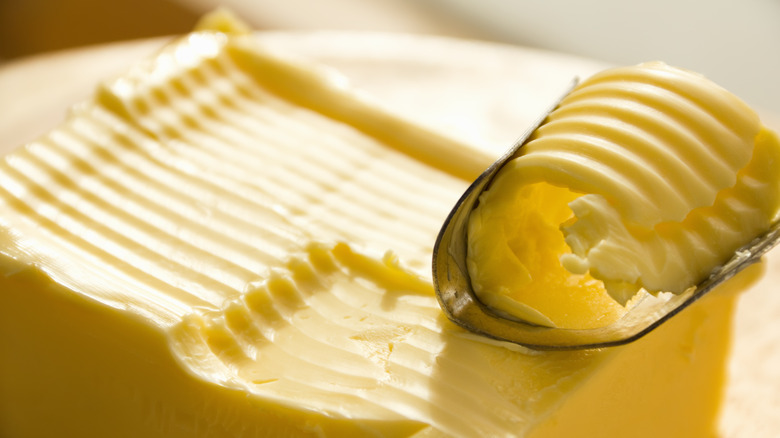The Butter Alternative To Grease A Bundt Pan If Your Cakes Stick
There's nothing worse than being forced to wreck the delicate surface of your bundt cake with a butter knife run messily around the rim because your cake has stuck to the ridges of the pan. Unlike other types of cake, where cracks and pockmarks can be hidden with a luxurious layer of frosting, the beauty of a bundt lies in its baked-in attractive design — you want it to release from the tin in one easy motion and serve it unadorned, or perhaps only with a light dusting of icing sugar or simple glacé icing. Of course, that means greasing your pan is a key part of getting that beautiful outer texture.
Butter is a useful go-to ingredient for greasing a bundt pan, but if you're out of the stuff, shortening is a great — and arguably better — alternative. This white fat is brilliant for preventing cakes from sticking to the tin and boasts a high smoke point, which means it doesn't burn at high oven temperatures. In turn, this reduces the chances of the sides of your bundt browning too much and developing an unwanted, crunchy texture.
How to grease a bundt pan with shortening
Fluted bundt pans — or those with decorative designs and edgings — have lots of nooks and crannies that need to be greased properly, and melting the shortening first is a great trick to ensuring every area is covered well. Use a pastry brush to apply the melted shortening to the pan, taking extra care to coat the central tube where baked cakes can often stick. If you don't have a pastry brush, a folded paper towel dipped into the melted shortening works too — just make sure you can get into all the little crevices of the pan.
After it's fully coated, sprinkle a small amount of flour into the pan, lift it on its side, and turn it slowly so the flour gently moves around the tin with each rotation and adheres to the surface. It can be helpful to tap the pan as you move it to encourage a light and even coating of flour. Turn the pan upside down over the sink to discard any extra flour and check you haven't missed a spot — if so, simply apply more shortening and flour to the area — add your batter, and get baking.
Why is shortening better than butter for greasing cake pans?
Butter is still a good option to grease bundt pans and is a common choice among many bakers, but shortening has the advantage in a couple of areas. Firstly, butter contains milk solids that can burn at lower temperatures than shortening. This occasionally causes bundt cakes to become crisp on the sides, making it trickier to turn them out without sticking or breaking. Secondly, some varieties of shortening that are made from a blend of vegetable oils instead of animal fats are suitable for vegetarians and vegans who are on a butter-free regimen. That makes it easier to grease the pans for vegan bundt recipes that don't contain milk, butter, and eggs.
Got some shortening left over? Use it to make fluffy frostings, tender cookies, and flaky pastries. And if you don't have shortening and really don't want to keep it on hand for one recipe, try using coconut oil to grease your cake pan instead. Similar to shortening, refined coconut oil is vegan-friendly and can withstand high temperatures, so it won't catch and burn while your bundt bakes.


